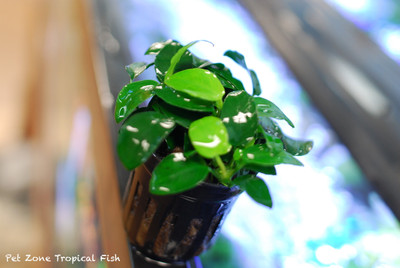Anubias Nana Petite
Posted by Max Gandara on on 30th May 2024
Anubias Nana Petite: The Perfect Plant for Aquascaping
Aquascaping is an art that combines the beauty of nature with the creativity of design, transforming aquariums into stunning underwater landscapes. One plant that has become a favorite among aquarists for its versatility and charm is Anubias nana 'Petite'. This diminutive yet hardy plant is ideal for creating intricate and captivating aquascapes. In this blog, we'll explore the characteristics, care requirements, and benefits of incorporating Anubias nana 'Petite' into your aquatic garden.
What is Anubias Nana 'Petite'?
Anubias nana 'Petite' is a smaller variant of Anubias barteri var. nana, a species native to the tropical regions of West Africa. Known for its compact size and attractive dark green leaves, this plant is perfect for nano aquariums and intricate aquascapes. It grows slowly and maintains a petite stature, making it an excellent choice for foreground placement or as an accent on hardscape elements like rocks and driftwood.
Why Choose Anubias Nana 'Petite'?
- Aesthetic Appeal: Anubias nana 'Petite' features small, round, dark green leaves that create a lush, vibrant look. Its compact growth habit adds a touch of elegance and natural beauty to any aquascape.
- Ease of Care: This plant is known for its hardiness and adaptability, making it suitable for both beginners and experienced aquarists. It can thrive in a variety of water conditions and requires minimal maintenance.
- Versatility: Anubias nana 'Petite' can be used in various parts of the aquarium, from the foreground to midground. Its small size and slow growth make it ideal for nano tanks and detailed aquascaping projects.
Growing Anubias Nana 'Petite'
Here are some essential tips for growing and maintaining Anubias nana 'Petite' in your aquarium:
1. Light Requirements
Anubias nana 'Petite' thrives under low to moderate lighting conditions. Too much light can promote algae growth on its leaves, so it's best to provide subdued lighting. This makes it an excellent choice for low-tech setups and shaded areas of the tank.
2. Water Parameters
- Temperature: This plant prefers water temperatures between 72-82°F (22-28°C).
- pH: The optimal pH range is 6.0-7.5, making it adaptable to various water conditions.
- Hardness: It can tolerate soft to moderately hard water.
3. Nutrients and CO2
Anubias nana 'Petite' does not have high nutrient demands and can grow well without CO2 supplementation. However, regular dosing with liquid fertilizers can enhance its growth and keep its leaves healthy and vibrant.
Planting and Propagation
1. Planting
Anubias nana 'Petite' should be attached to hardscape elements like rocks, driftwood, or other decorations. Avoid burying the rhizome (horizontal stem) in the substrate, as this can cause it to rot. Use fishing line or cotton thread to secure the plant to the desired surface until it attaches naturally.
2. Propagation
Propagation of Anubias nana 'Petite' is relatively simple. It can be done by dividing the rhizome. Use a sharp, sterile knife or scissors to cut the rhizome into smaller sections, ensuring each section has a few leaves and roots. Reattach the new sections to hardscape surfaces in the same manner as the parent plant.
Maintenance Tips
Maintaining Anubias nana 'Petite' involves minimal effort. Regularly inspect the plant for any dead or decaying leaves and remove them to prevent the buildup of detritus. Since this plant grows slowly, it does not require frequent trimming. Ensure proper water flow around the plant to prevent algae buildup on the leaves.
Common Issues and Solutions
- Algae Growth: Algae can sometimes grow on the leaves if the light is too strong or the nutrient balance is off. Maintain a balanced nutrient regimen and provide subdued lighting. Introducing algae-eating species like shrimp or snails can also help control algae.
- Rhizome Rot: Burying the rhizome in the substrate can cause it to rot. Ensure that the rhizome is always exposed to water and attached to a hard surface.
- Yellowing Leaves: If the leaves start turning yellow, it may indicate a nutrient deficiency. Check and adjust the nutrient levels in the water to promote healthy growth.
In Conclusion
Anubias nana 'Petite' is a charming and versatile plant that can enhance the beauty of any aquarium. Its small size, slow growth, and ease of care make it an excellent choice for aquarists of all levels. Whether you're creating a detailed aquascape or adding a touch of greenery to your tank, Anubias nana 'Petite' is a perfect choice. Add this delightful plant to your aquascape and enjoy the lush, vibrant look it brings to your underwater world!

